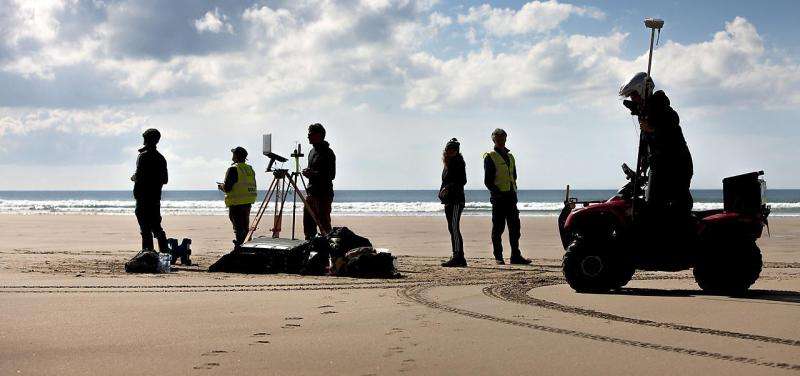Research explores beach recovery following severe storms

The recovery of beaches across the South West following the severe storms of 2013/14 is to be explored as part of a major new research initiative.
Led by Plymouth University, the project will aim to assess why many beaches that were severely eroded have still not recovered, even after three summers of calm wave conditions.
It is one of four work streams being pursued as part of the £4million BLUE-coast project, funded by the Natural Environment Research Council, aiming to specifically address the importance of sediment budgets, and their role in coastal recovery.
And it will be officially launched at a meeting to be attended by researchers from seven academic institutions and five stakeholders, including the Environment Agency, the Met Office and the National Trust, on Thursday 01 September 2016 in Perranporth, Cornwall.
Professor Gerd Masselink, who is leading the project at Plymouth University, said:
"Coastal research tends to focus on the more exciting aspects of coastal change, such as extreme coastal erosion. But the recovery of the coast from erosion is equally important. If the coast does not recover fully, it leaves the coasts vulnerable to subsequent storms or stormy periods. This project aims to understand and be able to predict the rate of recovery and the role of subaerial and submerged sediment stores in the recovery process."
Previous research led by Plymouth University and published in Geophysical Research Letters showed the 2013/14 winter was the most severe in terms of storm waves since at least 1948. Regardless of this, it had been expected the most of the sand lost as a result of those storms would have been replenished and the current research will aim to begin to investigate why that might not have happened.
The first two years of the project will see extensive field measurements at two key sites, the sandy beach and dune system of Perranporth on the north coast of Cornwall and the gravel beaches of Start Bay on the south coast of Devon. The second two years will then focus on developing new and improving existing computer models of coastal change, which can then be used to investigate the impact of different climate change scenarios and address issues of coastal vulnerability.
Professor Masselink added:
"A very exciting aspect of this project is that we aim to put together the total sediment budget of the beaches we study, so we also study dunes and the underwater part of the beach up to 20m water depth. This is rarely done, because it is very challenging to collect and combine such complete data sets. To complement the coastal survey data, we will also make in-situ measurements of waves and tidal currents across the intertidal and underwater profile beach under calm and energetic conditions using instruments deployed on the sea bed. We will also install a weather station in the coastal dunes to record wind speeds and sediment transport by wind."
The Environment Agency is among the project's stakeholders, so it can use the latest research to ensure coastal communities continue to be protected. It already funds the Plymouth Coastal Observatory, which is hosted by Plymouth University, to collect coastal data, including aerial photography, tide and wave information, and the topography of the coastline and nearshore zone.
Nick Ely, the Environment Agency's Area Coastal Engineer for Devon, Cornwall and the Isles of Scilly, said:
"Many beaches in the South West help absorb the wave energy that accompanies strong storms, and thereby reduce the risk of flooding and coastal erosion to the properties and businesses they front. We are excited to be partnering with the world leading experts at Plymouth University in this field of research, and hope the results of their research will enable us to help forecast future changes and better understand the risk from flooding and erosion that our coastal communities face."
BLUE-coast is a four-year project funded by the Natural Environment Research Council as part of the highlight topic, Coastal morphology: coastal sediment budgets and their role in coastal recovery. It will adopt a holistic and multidisciplinary approach, combining the expertise of biologists, coastal engineers, geologists, geographers, and oceanographers with complementary field, laboratory and numerical skills, to understand the processes controlling coastal system dynamics. It is led by the National Oceanography Centre in conjunction with Plymouth University, University of Liverpool, University of Cambridge, University of St Andrews, Birkbeck University of London, University of Southampton and Cardiff University.
More information: Gerd Masselink et al. Extreme wave activity during 2013/2014 winter and morphological impacts along the Atlantic coast of Europe, Geophysical Research Letters (2016). DOI: 10.1002/2015GL067492
Journal information: Geophysical Research Letters
Provided by University of Plymouth



















